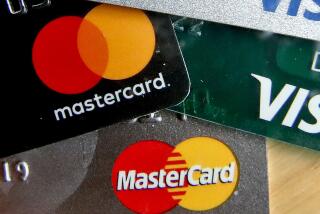Credit Card Companies Offering Home Improvement Deals
ATLANTA — Just in time for spring, credit offers are pouring in for homeowners looking to remodel kitchens, add a deck or take on other projects.
Credit card issuers, looking to profit as the peak season for home improvements begins, are sweetening terms for existing cardholders who make such purchases and are coming up with new incentives for home projects.
For example, JPMorgan Chase and Reader’s Digest Assn. Inc. launched a card that gives holders three points for each dollar spent on home improvement items and one point for other purchases.
Once 2,500 points are accumulated, consumers can get a $25 gift card to use at home-goods and electronics retailers.
Citibank, a unit of Citigroup Inc., is offering some credit card customers 5% cash back on purchases made at home improvement and furnishing stores.
“Card issuers are trying to find ways to differentiate, and it’s harder because this is a mature market,” said Claire Braverman, head of financial service practices for the Americas at market research firm Synovate.
Strength in the U.S. housing market has led credit companies to target consumers eager to maintain their property, she said.
“Everybody has offered cash back on gas and grocery, and home improvement is typically an area in which there’s not too much risk involved,” Braverman said.
Home improvement spending is rising. Homeowners poured $149.5 billion into remodeling projects during 2005, up 4.3% from the year before, according to the remodeling activity indicator of Harvard University’s Joint Center for Housing Studies.
Lowe’s Cos., the Mooresville, N.C.-based home improvement retailer, last month launched a credit card to give consumers a vehicle to finance bigger-ticket home projects.
At Lowe’s, an approved consumer opens the so-called project card with a minimum purchase of $1,000.
After the first purchase, consumers will have six months to make as many purchases as they like without interest or required payments.
At the end of the six months, repayment begins on any leftover balance.
“When we looked at our credit programs, there was clearly a gap, and we felt we needed another financing solution that would target larger-project sales,” said Mike Tummillo, Lowe’s vice president of credit services.
He said the project card, which is managed by General Electric Co.’s consumer finance unit, allowed credit lines of as much as $35,000, compared with about $10,000 for the regular Lowe’s credit card.
“We think it will be a very important sales feature and tool for our installed sales initiative,” Tummillo said.
Bolstered by demand for cabinets, countertops and flooring, Lowe’s installed sales came to $2.6 billion in 2005, a 31% rise over the previous year.
Home equity loans, which provide tax-deductible money for remodels or specific improvements, may not be the best financing vehicle because they have fees and can require much paperwork to process, Tummillo said.
“Where we have an advantage over home equity loans is the ease of application and processing,” Tummillo said.
More to Read
Inside the business of entertainment
The Wide Shot brings you news, analysis and insights on everything from streaming wars to production — and what it all means for the future.
You may occasionally receive promotional content from the Los Angeles Times.










